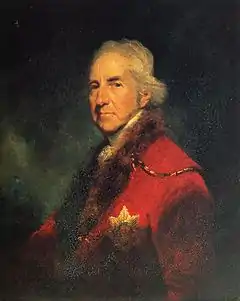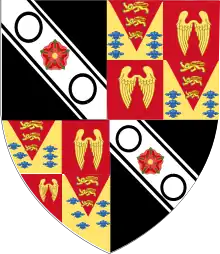Francis Seymour-Conway, 1st Marquess of Hertford
Francis Seymour-Conway, 1st Marquess of Hertford, KG, PC, PC (Ire) (5 July 1718 – 14 June 1794) was a British courtier and politician.
The Marquess of Hertford | |
|---|---|
 | |
| Lord Lieutenant of Ireland | |
| In office 7 August 1765 – 1766 | |
| Monarch | George III |
| Preceded by | Thomas Thynne, 1st Marquess of Bath |
| Succeeded by | George Hervey, 2nd Earl of Bristol |
| Personal details | |
| Born | Francis Seymour-Conway 5 July 1718 |
| Died | 14 June 1794 (aged 75) |
| Citizenship | British |

Background
Hertford was born in Chelsea, London, the son of Francis Seymour-Conway, 1st Baron Conway, and Charlotte Shorter, daughter of John Shorter of Bybrook. He was a descendant of Edward Seymour, 1st Duke of Somerset. He succeeded to the barony on the death of his father in 1732. The first few years after his father's death were spent in Italy and Paris. On his return to England he took his seat, as 2nd Baron Conway, among the Peers in November 1739. Henry Seymour Conway, politician and soldier, was his younger brother.
Political career
In August 1750 he was created Viscount Beauchamp and Earl of Hertford, both of which titles had earlier been created for and forfeited by his ancestor Edward Seymour, 1st Duke of Somerset, Lord Protector of England, following his attainder and execution in 1552. The Seymour family had inherited a moiety of the feudal barony of Hatch Beauchamp, in Somerset, by marriage to the heiress Cicely Beauchamp (d.1393). In 1755, according to Horace Walpole, 4th Earl of Orford, "The Earl of Hertford, a man of unblemished morals, but rather too gentle and cautious to combat so presumptuous a court, was named Ambassador to Paris." He appointed David Hume as his Secretary, who wrote of him, "I do not believe there is in the World a man of more probity & Humanity, endowd with a very good Understanding, and adornd with very elegant Manners & Behaviour".[2] However, due to the demands of the French, the journey to Paris was suspended. From 1751 to 1766 he was Lord of the Bedchamber to George II and George III. In 1756 he was made a Knight of the Garter and, in 1757, Lord-Lieutenant and Guardian of the Rolls of the County of Warwick and City of Coventry.
In 1763 he became Privy Councillor and, from October 1763 to June 1765, was a successful ambassador in Paris. He witnessed the sad last months of Madame de Pompadour, whom he admired, and wrote a kindly epitaph for her.[3] In the autumn of 1765 he became Viceroy of Ireland where, as an honest and religious man, he was well liked. An anonymous satirist in 1777 described him as "the worst man in His Majesty's dominions", and also emphasised Hertford's greed and selfishness, adding "I cannot find any term for him but avaricious." However, this anonymous attack does not seem to be justified.
In 1782, when she was only fifty-six, his wife died after having nursed their grandson at Forde's Farm, Thames Ditton, where she caught a violent cold. According to Walpole, "Lord Hertford's loss is beyond measure. She was not only the most affectionate wife, but the most useful one, and almost the only person I ever saw that never neglected or put off or forgot anything that was to be done. She was always proper, either in the highest life or in the most domestic." (Walpole visited Forde's Farm on several occasions from his residence at Strawberry Hill, Twickenham.) Within two years of the tragedy, Lord Hertford had sold Forde's Farm to Mrs Charlotte Boyle Walsingham, and a further two years later, she had re-developed the estate, building a new mansion which she called Boyle Farm, a name still in use today.
In July 1793 he was created Marquess of Hertford, with the subsidiary title of Earl of Yarmouth. He enjoyed this elevation for almost a year until his death at the age of seventy-six, on 14 June 1794, at the house of his daughter, the Countess of Lincoln. He died as the result of an infection following a minor injury he received while riding. He was buried at Arrow, in Warwickshire.
Marriage
_by_Alexander_Roslin.jpg.webp)
Hunterian Art Gallery, University of Glasgow
Lord Hertford married Lady Isabella Fitzroy, daughter of Charles FitzRoy, 2nd Duke of Grafton, on 29 May 1741. Her grandfather was Henry FitzRoy, 1st Duke of Grafton (1663-1690), an illegitimate son of King Charles II. By his wife he had thirteen children:
- Francis Seymour-Conway, 2nd Marquess of Hertford (12 February 1743 – 28 June 1822)
- Lady Anne Seymour-Conway (1 August 1744 – 4 November 1784), married Charles Moore, 1st Marquess of Drogheda.
- Lord Henry Seymour-Conway (15 December 1746 – 5 February 1830)
- Lady Sarah Frances Seymour-Conway (27 September 1747 – 20 July 1770), married Robert Stewart, 1st Marquess of Londonderry.
- Lord Robert Seymour-Conway (20 January 1748 – 23 November 1831)
- Lady Gertrude Seymour-Conway (9 October 1750 – September 1793), married George Mason-Villiers, 2nd Earl Grandison.
- Lady Frances Seymour-Conway (4 December 1751 – 11 November 1820), married Henry Fiennes Pelham-Clinton, Earl of Lincoln, a son of Henry Fiennes Pelham-Clinton, 2nd Duke of Newcastle.
- Rev. Hon. Edward Seymour-Conway (1752–1785), canon of Christ Church, Oxford, unmarried
- Lady Elizabeth Seymour-Conway (1754–1825) died unmarried
- Lady Isabella Rachel Seymour-Conway (25 December 1755 – 1825), married George Hatton, a member of parliament.
- Admiral Lord Hugh Seymour (29 April 1759 – 11 September 1801), married Lady Anne Horatia Waldegrave, a daughter of James Waldegrave, 2nd Earl Waldegrave
- Lord William Seymour-Conway (29 April 1759 – 31 January 1837)
- Lord George Seymour-Conway (21 July 1763 – 10 March 1848). He married Isabella Hamilton, granddaughter of James Hamilton, 7th Earl of Abercorn, and was the father of Sir George Hamilton Seymour, a British diplomatist.
He is not known to have suffered himself from any mental abnormality, but a noted strain of eccentricity, even madness, appeared among his descendants: the debauched behaviour of his grandson, the 3rd Marquess, and the suicide of another grandson, Viscount Castlereagh, were both attributed to a strain of madness supposed to be hereditary in the Seymour Conway family.[4]
Lord Hertford died in Surrey, England.
References
- Debrett's Peerage, 1968, pp.571,1036
- Klibansky, Raymond and Mossner, Ernest C. (eds.) (1954). New Letters of David Hume. Oxford: Oxford University Press, p.78.
- Mitford, Nancy Madame de Pompadour Hamish Hamilton 1954
- Hyde, Montgomery The Strange Death of Lord Castlereagh William Heinemann 1959 p.157
| Diplomatic posts | ||
|---|---|---|
| Preceded by The Duke of Bedford |
British Ambassador to France 1763–1765 |
Succeeded by The Duke of Richmond |
| Honorary titles | ||
| Preceded by The Earl Brooke |
Lord Lieutenant of Warwickshire 1757–1794 |
Succeeded by The Earl of Warwick |
| Preceded by The Lord Clive |
Lord Lieutenant of Montgomeryshire 1775–1776 |
Succeeded by The Earl of Powis |
| Political offices | ||
| Preceded by The Viscount Weymouth |
Lord Lieutenant of Ireland 1765–1766 |
Succeeded by The Earl of Bristol |
| Preceded by The Duke of Rutland |
Master of the Horse 1766 |
Succeeded by The Duke of Ancaster and Kesteven |
| Preceded by The Duke of Portland |
Lord Chamberlain 1766–1782 |
Succeeded by The Duke of Manchester |
| Preceded by The Duke of Manchester |
Lord Chamberlain 1783 |
Succeeded by The Earl of Salisbury |
| Peerage of Great Britain | ||
| New creation | Marquess of Hertford 1793–1794 |
Succeeded by Francis Seymour-Conway |
| Earl of Hertford 1750–1794 | ||
| Peerage of England | ||
| Preceded by Francis Seymour-Conway |
Baron Conway 1732–1794 |
Succeeded by Francis Seymour-Conway |
